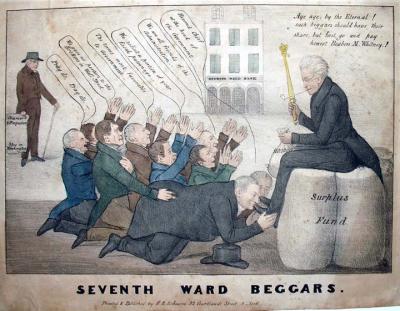Henry R. Robinson (active 1833-1851), Seventh Ward Beggars, ca. 1836. Lithograph with hand coloring. Graphic Arts GA 2010- in process
This print shows Andrew Jackson (1767-1845), the seventh president of the United States, sitting on the government’s surplus funds, holding a bag of $100,000. Jackson had succeeded in destroying the Bank of the United States in 1832. He and his “kitchen” cabinet established a series of pet banks—state institutions used by the federal government as depositories for public funds. One such pet bank was the Seventh Ward Bank, seen in the back center, which was established in 1833.
Jackson had the power to distribute bank funds and in this print we see nine bankers begging for money, two are literally kissing his feet. Jackson tells them to first pay honest Rueben M. Whitney, a former director of the Bank of United States, now working for Jackson. In the back left stands a Courier Enquirer reporter who later opened an investigation into the bonus fund money used to pay off Whitney.
The beggars say, “Revered Chief at the head of the Government - We are all friends of the Administration - We solicit a portion of your fiscal patronage - The terms most favorable to Government - We gave no portion to the Brokers in Wall Street - Pray do, Pray do.”
In 1928, a portrait of Grover Cleveland was removed from the twenty dollar bill and replaced with a portrait of Andrew Jackson. According to the U.S. Treasury, “Treasury Department records do not reveal the reason that portraits of these particular statesmen were chosen in preference to those of other persons of equal importance and prominence.”
See also: John M. McFaul and Frank Otto Gatell, “The Outcast Insider: Reuben M. Whitney and the Bank War,” The Pennsylvania Magazine of History and Biography 91, no. 2 (April 1967): 115-44.
